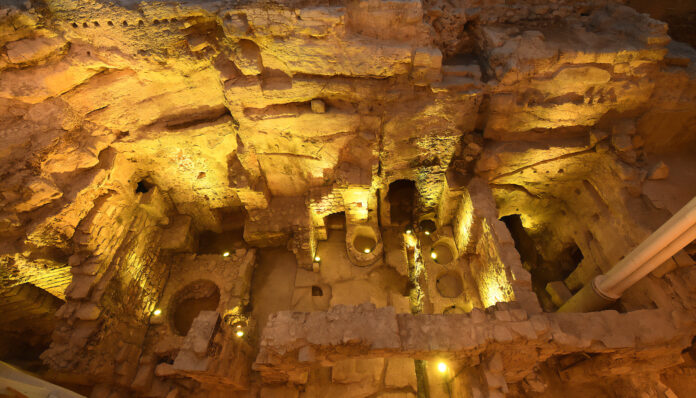If you’ve visited the Kosel in the past few years, you may have noticed an excavation project at the far end of the plaza. It has always piqued my interest. On my recent visit to the Kosel, the Rav Hakosel, Rav Shmuel Rabinovitch gave me an exclusive tour of the work being done there.
As a guest of the rav of the Kosel, I’m able to park in a VIP lot in the Kosel plaza, which gives me a few minutes to say some kapitlach Tehillim at the Wall before heading into the meeting. As I wash my hands afterward, I notice a group of Muslims in traditional clothing pointing to the Kosel. I approach them and learn that they are a group of imams from Oxford, England.
“We came to visit Israel so we could experience it,” one of them explains. They are pleased that I, a fellow Brit, stopped to speak with them. I wish I had more time to chat and show them around, but it’s time for my appointment. After agreeing to meet again in England, we say goodbye.
The office of the rav of the Kosel is located on the second floor of the WWHF building, overlooking the plaza. Large ornate bookcases line the walls of the office and hold an impressive collection of sefarim. Many of them are about the history of the Kosel and responsa related to it, including volumes written by Rav Shmuel Rabinovitch himself.
He invites me to sit down at his large oak desk and tells me about his experience as the fourth rav in this position, a lifetime appointment he’s held since 2000. “I’ve been doing this for more than 20 years,” he says in a soft, calm voice. “But on the scale of the Kosel’s 2,000-year history, 20 years does not feel like much.”
He tells me about the first rav of the Kosel, Rav Yitzchak Orenstein, and shows me his predecessor’s diary, documenting daily activity at the Kosel. Rav Orenstein was appointed during the British Mandate in 1930 in response to the 1929 massacre—the excuse for which was the mechitzah that was built at the Kosel. The Arabs used it as a pretext to claim that the Jews were trying to take over the Al-Aqsa compound, and they launched their murderous campaign. After that, Jewish leadership at the Kosel was an imperative. Rav Orenstein held his post until 1948, when he and his wife were tragically killed during the shelling of the Old City by the Jordanian Legion.
From its founding, the role of Rav HaKosel has been a delicate one. “This of course the holiest place for us,” Rav Rabinovitch says, “but it is also an important site internationally, both from a political and a religious standpoint. It may be a small place, but any misstep has the potential to ignite the entire region, perhaps even the whole world.
“The Kosel belongs to every single Jew,” the rav says. “It is important that everyone feels this way.” To that end, he oversees every detail in order to accommodate Jews from all walks of life. First of all, unlike other Jewish sites around the world, food is not served at the Kosel, in order to maintain its exceptional spiritual atmosphere. Second, the needs of each community are taken into consideration.
“The Sefardim lead the main Selichos minyan at the Kosel except on Motzaei Rosh Hashanah, because we know that many chasidim travel to their rebbes in Yerushalayim for Yom Tov. That night is perhaps the only time they might get to come to the Kosel before they return home, so we want them to reach the Kosel easily.”
Despite his best efforts, controversy can never be completely avoided. “Sometimes the best way to act is to remain silent,” he says softly. “I am not saying that it’s easy; I get flak sometimes. But people need to understand that there is a lot of work we are doing behind the scenes, and not everything can or must be said in public.
To read more, subscribe to Ami





















